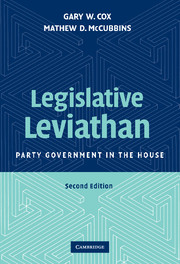Book contents
- Frontmatter
- Contents
- List of Figures
- List of Tables
- Acknowledgments
- Legislative Leviathan
- Introduction
- PART ONE THE AUTONOMY AND DISTINCTIVENESS OF COMMITTEES
- PART TWO A THEORY OF ORGANIZATION
- PART THREE PARTIES AS FLOOR-VOTING COALITIONS
- PART FOUR PARTIES AS PROCEDURAL COALITIONS
- PART FIVE PARTIES AS PROCEDURAL COALITIONS
- Conclusion
- Appendix 1 Uncompensated Seniority Violations, Eightieth through Hundredth Congresses
- Appendix 2 A Model of the Speaker's Scheduling Preferences
- Appendix 3 Unchallengeable and Challengeable Vetoes
- Appendix 4 The Scheduling Power
- Bibliography
- Author Index
- Subject Index
Appendix 2 - A Model of the Speaker's Scheduling Preferences
Published online by Cambridge University Press: 05 June 2012
- Frontmatter
- Contents
- List of Figures
- List of Tables
- Acknowledgments
- Legislative Leviathan
- Introduction
- PART ONE THE AUTONOMY AND DISTINCTIVENESS OF COMMITTEES
- PART TWO A THEORY OF ORGANIZATION
- PART THREE PARTIES AS FLOOR-VOTING COALITIONS
- PART FOUR PARTIES AS PROCEDURAL COALITIONS
- PART FIVE PARTIES AS PROCEDURAL COALITIONS
- Conclusion
- Appendix 1 Uncompensated Seniority Violations, Eightieth through Hundredth Congresses
- Appendix 2 A Model of the Speaker's Scheduling Preferences
- Appendix 3 Unchallengeable and Challengeable Vetoes
- Appendix 4 The Scheduling Power
- Bibliography
- Author Index
- Subject Index
Summary
A Speaker must decide which of a finite set of bills, B = {1, …, B}, to schedule in a finite amount of time. We think of the set B as containing all bills reported from standing and conference committees, as of a given time. B could be given a time subscript to emphasize that it changes over time, as new bills are reported, but we dispense with that notational clutter here. Each bill is in a certain “state” describing its floor progress: some have not yet received any consideration, some have been read a first time, some have been sent to conference, and so forth. The possible states in which a bill might be are indexed by the integers 1, …, S.
This is a discrete time model, meaning that time is thought of as being divided into a sequence of discrete periods. In any given period, exactly one of the B bills must be selected for further development. If bill b is selected and is in state s, a “reward” Rbs is collected (which can be zero or negative) and bill b makes a transition from state s to state u with probability Pbsu. Thus, for example, if bill b is in state 1 and the states are numbered consecutively (higher numbers meaning more advanced stages of development), then b may have a probability Pb11 of failing to advance, a probability of Pb12 of advancing one stage, a probability Pb13 of advancing two stages, and so forth.
- Type
- Chapter
- Information
- Legislative LeviathanParty Government in the House, pp. 263 - 266Publisher: Cambridge University PressPrint publication year: 2007



